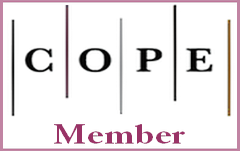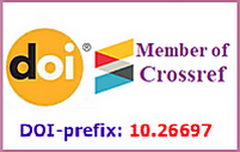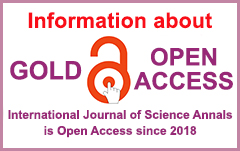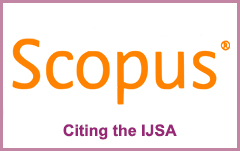Stadnik A. V. 1,2, Mykhaylyshyn U. B. 2, Wasilewski B. 3, Pypenko I. S. 1,4
| 1 Kharkiv Regional Public Organization “Culture of Health”, Ukraine 2 Uzhhorod National University, Ukraine 3 Psychosomatic Institute, Poland 4 Scientific Research Institute KRPOCH, Ukraine |
Abstract
Background and Aim of Study: The war in Ukraine, which is still ongoing, has a significant impact on the mental state of each individual. The same applies to university students forced to seek refuge inside or outside the country.
The aim of the study: to identify the characteristics of psychological distress experienced by university students in a war context and the role of a healthy lifestyle in overcoming it.
Material and Methods: The study was conducted by Uzhhorod National University (Ukraine) in February 2025, involving the administration of adapted DASS-21 and HPLP-II psychological tests via the Google Forms platform. The respondents, aged between 18 and 35, were divided into two groups: those who were forced to relocate to other regions (European Union and Ukraine) and those who did not change their place of residence (Ukraine). Psychological distress and healthy lifestyle behaviours among students in wartime were identified using the DASS and HPLP-II. These tools demonstrated high internal consistency, with values ranging from 0.916 to 0.951. There was a statistically significant negative correlation between psychological distress and health-promoting lifestyles.
Results: The levels of depression and anxiety were significantly higher among students in Group 1 than among those in Group 2. The study revealed the following gender-related findings: high average scores on the Depression and Anxiety scales (13.4 and 12.3 points, respectively) among women in Group 1; high average scores on the Stress scale (12.4 and 12.1 points, respectively) among men in all groups. The following healthy lifestyle practices play an important role in helping both groups to overcome the symptoms of psychological distress: interpersonal relationships (2.8 / 3.0 points), spiritual growth (2.8 / 2.9 points), and stress management (2.6 / 2.7 points). They had high and moderate HPLP-II scores. Students in Groups 1 and 2 demonstrated poor use of practices such as taking responsibility for their health (2.15 and 2.23 points), being physically active (2.2 and 2.3 points) and eating healthily (2.3 and 2.4 points). They had low HPLP-II scores.
Conclusions: The high levels of depression and anxiety experienced by university students during the war were caused by a combination of psychogenic factors and their own behaviour. It does not promote mental health. The study results indicate the need to introduce measures that increase motivation for personal health and physical activity among university students, tailored to their specific requirements and needs.
Keywords
psychological distress, anxiety, depression, stress, healthy lifestyle students, war
References
Agudelo-Suárez, A., Gil-González, D., Ronda-Pérez, E., Porthé, V., Paramio-Pérez, G., García, A. M., & Garí, A. (2009). Discrimination, work and health in immigrant populations in Spain. Social Science & Medicine, 68(10), 1866–1874. https://doi.org/10.1016/j.socscimed.2009.02.046
Basharpoor, S., Heydarirad, H., Atadokht, A., Daryadel, S. J., & Nasiri-Razi, R. (2015). The role of health beliefs and health promoting lifestyle in predicting pregnancy anxiety among pregnant women. Journal of Health Education and Health Promotion, 3(3), 171–180. https://journal.ihepsa.ir/article-1-260-en.html
Bedford, A., & Deary, I. J. (1999). The Delusions-Symptoms-States Inventory (DSSI): Construction, applications and structural analyses. Personality and Individual Differences, 26(3), 397-424. https://doi.org/10.1016/S0191-8869(98)00118-4
Bi, J., Huang, Y., Xiao, Y., Cheng, J., Li, F., Wang, T., Chen, J., Wu, L., Liu, Y., Luo, R., & Zhao, X. (2014). Association of lifestyle factors and suboptimal health status: a cross-sectional study of Chinese students. BMJ Open, 4, Article e005156. https://doi.org/10.1136/bmjopen-2014-005156
Biswas, P. R., Ahammed, B., Rahman, M. S., Nirob, B. M., & Hossain, M. T. (2022). Hossain prevalence and determinants of internet addiction among adults during the COVID-19 pandemic in Bangladesh: An online cross-sectional study. Heliyon, 8(7), Article e09967. https://doi.org/10.1016/j.heliyon.2022.e09967
Blanco Naranjo, E. G., Chavarría Campos, G. F., & Garita Fallas, Y. M. (2021). Estilo de vida saludable en diabetes mellitus tipo 2: Beneficios en el manejo crónico [Healthy lifestyle in type 2 diabetes mellitus: Benefits in chronic management]. Revista Medica Sinergia, 6(2), Article e639. https://doi.org/10.31434/rms.v6i2.639
Castillo-Díaz, M. A., Martínez, M. C., Periañez, C. A. H., & Sauceda-Acosta, D. (2024). Psychological distress, health-promoting lifestyle and sociodemographic factors in Honduran university students: a structural equation model. Health Promotion International, 39(4), Article daae082. https://doi.org/10.1093/heapro/daae082
Chao, D. P. (2023). Health-promoting lifestyle and its predictors among health-related and non-health-related university students in Taiwan: A cross-sectional quantitative study. BMC Public Health 23, Article 827. https://doi.org/10.1186/s12889-023-15760-2
Crawford, J. R., & Henry, J. D. (2003). The Depression Anxiety Stress Scales (DASS): Normative data and latent structure in a large non-clinical sample. The British Journal of Clinical Psychology, 42(Pt 2), 111–131. https://doi.org/10.1348/014466503321903544
Dhiman, S., & Chawla, G. K. (2017). A study on health promoting lifestyle of university students. International Journal of Research in Engineering and Applied Sciences, 7(6), 142–151. https://euroasiapub.org/a-study-on-health-promoting-lifestyle-of-university-students/
Du, M., Kong, H., Ran, L., Ran, Y., Bai, L., Du, Y., Guan, H., Dong, Y., & Zhao, Y. (2022). Associations among health-promoting lifestyle, self-care agency and health-related quality of life in Bai older adults with hypertension in Yunnan China. BMC Geriatrics, 22(1), Article 942. https://doi.org/10.1186/s12877-022-03608-0
Jasinskaja-Lahti, I., Liebkind, K., & Perhoniemi, R. (2007). Perceived ethnic discrimination at work and well-being of immigrants in Finland: The moderating role of employment status and work-specific group-level control beliefs. International Journal of Intercultural Relations, 31(2), 223–242. https://doi.org/10.1016/j.ijintrel.2006.02.003
Johnson, R. L. (2005). Gender differences in health-promoting lifestyles of African Americans. Public Health Nursing, 22(2), 130–13 7. https://doi.org/10.1111/j.0737-1209.2005.220206.x
Henry, J. D., & Crawford J. R. (2005). The short-form version of the Depression Anxiety Stress Scales (DASS-21): Construct validity and normative data in a large non-clinical sample. British Journal of Clinical Psychology, 44(2), 227–239. https://doi.org/10.1348/014466505X29657
Hope, V., & Henderson, M. (2014). Medical student depression, anxiety and distress outside North America: A systematic review. Medical Education in Review, 48(10), 963–979. https://doi.org/10.1111/medu.12512
Islam, M. S., Sujan, M. S. H., Tasnim, R., Sikder, M. T., Potenza, M. N., & van Os, J. (2020). Psychological responses during the COVID-19 outbreak among university students in Bangladesh. PLoS One, 15(12), Article e0245083. https://doi.org/10.1371/journal.pone.0245083
Kang, Y. S., Ha, Y. M., & Eun, Y. (2012). Health status and health-promoting lifestyle profile ii of North Korean immigrants. Journal of Korean Academy of Community Health Nursing, 23(3), 231–243. https://doi.org/10.12799/jkachn.2012.23.3.231
Kaparounaki, C. K., Patsali, M. E., Mousa, D. V., Papadopoulou, E. V. K., Papadopoulou, K. K. K., & Fountoulakis, K. N. (2020). University students’ mental health amidst the COVID-19 quarantine in Greece. Psychiatry Research, 290, Article 113111. https://doi.org/10.1016/j.psychres.2020.113111
Kegler, M. C., Kingsley, B., Malcoe, L. H., Cleaver, V., Reid, J., & Solomon, G. (1999). The functional value of smoking and nonsmoking from the perspective of American Indian youth. Family and Community Health, 22, 31–42. https://doi.org/10.1097/00003727-199907000-00005
Kurt, G., Ilkkursun, Z., Javanbakht, A., Uygun, E., Karaoglan-Kahilogullari, A., & Acarturk, C. (2021). The psychological impacts of COVID-19 related stressors on Syrian refugees in Turkey: The role of resource loss, discrimination, and social support. International Journal of Intercultural Relations, 85, 130–140. https://doi.org/10.1016/j.ijintrel.2021.09.009
Leiler, A., Bjarta, A., Ekdahl, J., & Wasteson, E. (2019). Mental health and quality of life among asylum seekers and refugees living in refugee housing facilities in Sweden. Social Psychiatry and Psychiatric Epidemiology, 54(5), 543–551. https://doi.org/10.1007/s00127-018-1651-6
Li, H., Liu, X., Zheng, Q., Zeng, S., & Luo, X. (2022). Gender differences and determinants of late-life depression in China: A cross-sectional study based on CHARLS. Journal of Affective Disorders, 309, 178–185. https://doi.org/10.1016/j.jad.2022.04.059
Lim, B. C., Kueh, Y. C., Arin, W. N., & Ng, K. H. (2016). Validation of health-promoting lifestyle profile-II: a confirmatory study with a Malaysian Undergraduate Students sample. Education in Medicine Journal, 8(2), 65–77. https://doi.org/10.5959/eimj.v8i2.438
Lovibond, S. H., & Lovibond, P. F. (1995). Depression Anxiety Stress Scales (DASS-21, DASS-42) [Database record]. APA PsycTests. https://doi.org/10.1037/t01004-000
Melnyk, Yu. B., & Stadnik, A. V. (2020). Medical and psychological support to specialists under conditions of pandemic COVID-19. Minerva Psichiatrica, 61(3), 109–112. https://doi.org/10.23736/S0391-1772.20.02083-X
Melnyk, Y. B., Stadnik, A. V., Mykhaylyshyn, U. B., Vveinhardt, J., De Frias, C. M., & Pypenko, I. S. (2024). Mental health and life satisfaction of university students influenced by war. International Journal of Science Annals, 7(2), 35–45. https://doi.org/10.26697/ijsa.2024.2.6
Melnyk, Yu. B., Stadnik, A. V., Pypenko, I. S., Kostina, V. V., & Yevtushenko, D. O. (2022). Impact of COVID-19 on the Social and Psychological State of Athletes. The Journal of Sports Medicine and Physical Fitness, 62(2), 297–299. https://doi.org/10.23736/S0022-4707.21.12401-6
Melnyk, Yu. B., & Stadnik, A. V. (2025). Profil zdorovoho sposobu zhyttia (versiia dlia doroslykh) [Health-Promoting Lifestyle Profile (Adult Version)]. KRPOCH. https://doi.org/10.26697/sri.krpoch/melnyk.stadnik.4.2025
Melnyk, Yu. B., & Stadnik, A. V. (2023). Shkala depresii, tryvohy ta stresu [Depression, Anxiety and Stress Scale]. KRPOCH. https://doi.org/10.26697/sri.krpoch/melnyk.stadnik.4.2023
Mohamed, S. H., Altunkurek, S. Z., Eker, H. H., Ozcoban, K., Hacimustafaoglu, F., & Abdi, I. A. (2022), Health-promoting lifestyle and its determinants among university students in Mogadishu, Somalia. African Journal of Health, Nursing and Midwifery, 5(4), 71–86. https://doi.org/10.52589/AJHNM-MLRW8SUI
Morais, C., Amorim, I., Viana, C., & Ferreira, S. (2020). Estilos de vida e bem-estar de estudantes do ensino superior [Higher education students’ lifestyles and welfare]. Revista Portuguesa de Enfermagem de Saúde Mental, 7, 57–64. https://doi.org/10.19131/rpesm.0248
Mykhaylyshyn, U. B., Stadnik, A. V., Melnyk, Yu. B., Vveinhardt, J., Oliveira, M. S., & Pypenko, I. S. (2024). Psychological stress among university students in wartime: A longitudinal study. International Journal of Science Annals, 7(1), 27–40. https://doi.org/10.26697/ijsa.2024.1.6
Nazik, H., Nazik, E., Özdemir, F., Gül, Ş., Tezel, A., & Narin, R. (2015). Effect of parity on healthy promotion lifestyle behavior in women. Contemporary Nurse, 50(2-3), 267–273. https://doi.org/10.1080/10376178.2015.1081072
Ors, M. (2024) Healthy lifestyle behaviors among teachers working in public primary schools and affecting factors. Frontiers in Public Health, 12, Article 1382385. https://doi.org/10.3389/fpubh.2024.1382385
Pypenko, I. S., Maslov, Yu. V., & Melnyk, Yu. B. (2020). The impact of social distancing measures on higher education stakeholders. International Journal of Science Annals, 3(2), 9–14. https://doi.org/10.26697/ijsa.2020.2.2
Pypenko, I. S., Stadnik, A. V., Melnyk, Yu. B., & Mykhaylyshyn, U. B. (2023). The impact of the war in Ukraine on the psychological well-being of students. International Journal of Science Annals, 6(2), 20–31. https://doi.org/10.26697/ijsa.2023.2.2
Safa, F., Anjum, A., Hossain, S., Trisa, T. I., Alam, S. F., Abdur Rafi, M., Podder, V., Koly, K. N., Azad, D. T., Ahmad, W. U., Nodi, R. N., Ashraf, F., Quamrul Akhter, S. M., Ahmed, H. U., & Hasan, M. T. (2021). Immediate psychological responses during the initial period of the COVID-19 pandemic among Bangladeshi medical students. Children and Youth Services Review, 122, Article 105912. https://doi.org/10.1016/j.childyouth.2020.105912
Safaie, N., Ketabi, S., Kia, N., Mirmohammadkhani, M., Moonesan, M., & Paknazar, F. (2020) Exploration of mental health problems in association with health-promoting lifestyle profile in Iranian medical students: a cross-sectional study. Journal of Education and Health Promotion, 9, 84. https://doi.org/10.4103/jehp.jehp_582_19
Sazakli, E., Leotsinidis, M., Bakola, M., Kitsou, K.S., Katsifara, A., Konstantopoulou, A., & Jelastopulu, E. (2021). Prevalence and associated factors of anxiety and depression in students at a Greek university during COVID-19 lockdown. Journal of Public Health Research, 10(3). https://doi.org/10.4081/jphr.2021.2089
Siddik, M.A. B., Ali, A., Miah, S., Hasan, M., Ahmed, M., & Sunna, T. C. (2024). Psychological disorders among college going students: a post COVID-19 insight from Bangladesh. Journal of Affective Disorders Reports, 15, Article 00686. https://doi.org/10.1016/j.jadr.2023.100686
Slonim, J., Kienhuis, M., Di Benedetto, M., & Reece, J. (2015) The relationships among self-care, dispositional mindfulness, and psychological distress in medical students. Medical Education Online, 20(1), Article 27924. https://doi.org/10.3402/meo.v20.27924
Sousa, P., Gaspar, P., Vaz, D. C., Gonzaga, S., & Dixe, M. A. (2015). Measuring health-promoting behaviors: Cross-cultural validation of the Health-Promoting Lifestyle Profile-II. International Journal of Nursing Knowledge, 26(2), 54–61. https://doi.org/10.1111/2047-3095.12065
Stadnik, A. V., Melnyk, Yu. B., Babak, S. A., Vashchenko, I. V., & Krut, P. P. (2022). Psychological distress among students and cadets of universities in the war conditions. International Journal of Science Annals, 5(1-2), 20–29. https://doi.org/10.26697/ijsa.2022.1-2.0
Stadnik, A. V., Melnyk, Yu. B., Mykhaylyshyn, U. B., & de Matos, M. G. (2023). Peculiarities of the psychological well-being and social adaptation of young students and cadets in wartime conditions. International Journal of Science Annals, 6(1), 22–30. https://doi.org/10.26697/ijsa.2023.1.7
Walker, S. N., Sechrist, K. R., & Pender, N. J. (1987). The health-promoting lifestyle prole: Development and psychometric characteristics. Nursing Research, 36(2), 76–81. https://doi.org/10.1097/00006199-198703000-00002
Wei, C. N., Harada, K., Ueda, K., Fukumoto, K. Minamoto, K., & Ueda, A. (2012). Assessment of health-promoting lifestyle profile in Japanese university students. Environmental Health and Preventive Medicine, 17(3), 222–227. https://doi.org/10.1007/s12199-011-0244-8
Yahia, N., Wang, D., Rapley, M., & Dey, R. (2016). Assessment of weight status, dietary habits and beliefs, physical activity, and nutritional knowledge among university students. Perspectives in Public Health, 136(4), 231–244. https://doi.org/10.1177/1757913915609945
Zheng, Z., Zhao, W., Zhou, Q., Yang, Y., Chen, S., Hu, J., Jiang, W., Zhang, W., Cai, J., & Qiu, J. (2023). Sex differences in depression, anxiety and health-promoting lifestyles among community residents: A network approach. Journal of Affective Disorders, 340, 369–378. https://doi.org/10.1016/j.jad.2023.07.107
Stadnik Anatoliy Volodymyrovych – https://orcid.org/0000-0002-1472-4224; Doctor of Philosophy in Medicine, Affiliated Associate Professor, Kharkiv Regional Public Organization “Culture of Health”, Kharkiv, Ukraine; Uzhhorod National University, Uzhhorod, Ukraine.
Mykhaylyshyn Ulyana Bohdanivna – https://orcid.org/0000-0002-0225-8115; Doctor of Psychological Sciences, Full Professor; Head of the Department of Psychology, Uzhhorod National University, Uzhhorod, Ukraine.
Wasilewski Bohdan – https://orcid.org/0000-0001-6892-4021; Doctor of Philosophy in Medicine, MD, Professor, Psychosomatic Institute, Warsaw, Poland.
Pypenko Iryna Sergiivna (Corresponding Author) – https://orcid.org/0000-0001-5083-540X;
| |
APA
Stadnik, A. V., Mykhaylyshyn, U. B., Wasilewski, B., & Pypenko, I. S. (2025). Psychological distress and healthy lifestyle among university students in wartime. International Journal of Science Annals, 8(1), 33–44. https://doi.org/10.26697/ijsa.2025.1.3
Harvard
Stadnik, A. V., Mykhaylyshyn, U. B., Wasilewski, B., & Pypenko, I. S. "Psychological distress and healthy lifestyle among university students in wartime." International Journal of Science Annals, [online] 8(1), pp. 33–44. viewed 30 June 2025, https://culturehealth.org/ijsa_archive/ijsa.2025.1.3.pdfVancouver
Stadnik A. V., Mykhaylyshyn U. B., Wasilewski B., & Pypenko I. S. Psychological distress and healthy lifestyle among university students in wartime. Journal of Science Annals [Internet]. 2025 [cited 30 June 2025]; 8(1): 33–44. Available from: https://culturehealth.org/ijsa_archive/ijsa.2025.1.3.pdf https://doi.org/10.26697/ijsa.2025.1.3












